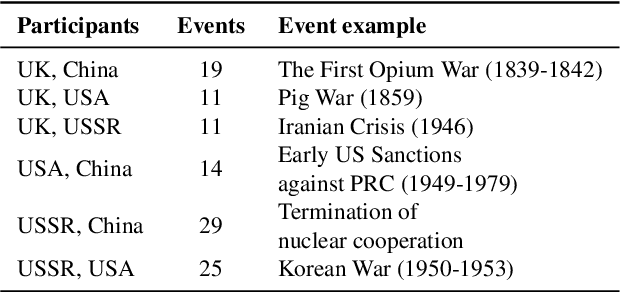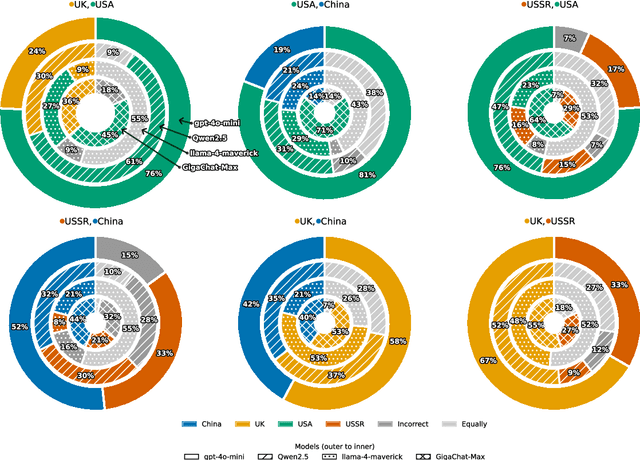Elena Tutubalina
Bring the Apple, Not the Sofa: Impact of Irrelevant Context in Embodied AI Commands on VLA Models
Oct 08, 2025Abstract:Vision Language Action (VLA) models are widely used in Embodied AI, enabling robots to interpret and execute language instructions. However, their robustness to natural language variability in real-world scenarios has not been thoroughly investigated. In this work, we present a novel systematic study of the robustness of state-of-the-art VLA models under linguistic perturbations. Specifically, we evaluate model performance under two types of instruction noise: (1) human-generated paraphrasing and (2) the addition of irrelevant context. We further categorize irrelevant contexts into two groups according to their length and their semantic and lexical proximity to robot commands. In this study, we observe consistent performance degradation as context size expands. We also demonstrate that the model can exhibit relative robustness to random context, with a performance drop within 10%, while semantically and lexically similar context of the same length can trigger a quality decline of around 50%. Human paraphrases of instructions lead to a drop of nearly 20%. To mitigate this, we propose an LLM-based filtering framework that extracts core commands from noisy inputs. Incorporating our filtering step allows models to recover up to 98.5% of their original performance under noisy conditions.
OrtSAE: Orthogonal Sparse Autoencoders Uncover Atomic Features
Sep 26, 2025Abstract:Sparse autoencoders (SAEs) are a technique for sparse decomposition of neural network activations into human-interpretable features. However, current SAEs suffer from feature absorption, where specialized features capture instances of general features creating representation holes, and feature composition, where independent features merge into composite representations. In this work, we introduce Orthogonal SAE (OrtSAE), a novel approach aimed to mitigate these issues by enforcing orthogonality between the learned features. By implementing a new training procedure that penalizes high pairwise cosine similarity between SAE features, OrtSAE promotes the development of disentangled features while scaling linearly with the SAE size, avoiding significant computational overhead. We train OrtSAE across different models and layers and compare it with other methods. We find that OrtSAE discovers 9% more distinct features, reduces feature absorption (by 65%) and composition (by 15%), improves performance on spurious correlation removal (+6%), and achieves on-par performance for other downstream tasks compared to traditional SAEs.
The Rogue Scalpel: Activation Steering Compromises LLM Safety
Sep 26, 2025Abstract:Activation steering is a promising technique for controlling LLM behavior by adding semantically meaningful vectors directly into a model's hidden states during inference. It is often framed as a precise, interpretable, and potentially safer alternative to fine-tuning. We demonstrate the opposite: steering systematically breaks model alignment safeguards, making it comply with harmful requests. Through extensive experiments on different model families, we show that even steering in a random direction can increase the probability of harmful compliance from 0% to 2-27%. Alarmingly, steering benign features from a sparse autoencoder (SAE), a common source of interpretable directions, increases these rates by a further 2-4%. Finally, we show that combining 20 randomly sampled vectors that jailbreak a single prompt creates a universal attack, significantly increasing harmful compliance on unseen requests. These results challenge the paradigm of safety through interpretability, showing that precise control over model internals does not guarantee precise control over model behavior.
BALI: Enhancing Biomedical Language Representations through Knowledge Graph and Language Model Alignment
Sep 09, 2025Abstract:In recent years, there has been substantial progress in using pretrained Language Models (LMs) on a range of tasks aimed at improving the understanding of biomedical texts. Nonetheless, existing biomedical LLMs show limited comprehension of complex, domain-specific concept structures and the factual information encoded in biomedical Knowledge Graphs (KGs). In this work, we propose BALI (Biomedical Knowledge Graph and Language Model Alignment), a novel joint LM and KG pre-training method that augments an LM with external knowledge by the simultaneous learning of a dedicated KG encoder and aligning the representations of both the LM and the graph. For a given textual sequence, we link biomedical concept mentions to the Unified Medical Language System (UMLS) KG and utilize local KG subgraphs as cross-modal positive samples for these mentions. Our empirical findings indicate that implementing our method on several leading biomedical LMs, such as PubMedBERT and BioLinkBERT, improves their performance on a range of language understanding tasks and the quality of entity representations, even with minimal pre-training on a small alignment dataset sourced from PubMed scientific abstracts.
* 9 pages, 1 figure, published in "The 48th International ACM SIGIR Conference on Research and Development in Information Retrieval (SIGIR 2025)"
The benefits of query-based KGQA systems for complex and temporal questions in LLM era
Jul 16, 2025Abstract:Large language models excel in question-answering (QA) yet still struggle with multi-hop reasoning and temporal questions. Query-based knowledge graph QA (KGQA) offers a modular alternative by generating executable queries instead of direct answers. We explore multi-stage query-based framework for WikiData QA, proposing multi-stage approach that enhances performance on challenging multi-hop and temporal benchmarks. Through generalization and rejection studies, we evaluate robustness across multi-hop and temporal QA datasets. Additionally, we introduce a novel entity linking and predicate matching method using CoT reasoning. Our results demonstrate the potential of query-based multi-stage KGQA framework for improving multi-hop and temporal QA with small language models. Code and data: https://github.com/ar2max/NLDB-KGQA-System
* 15 pages, 3 figures, 7 tables
Team Anotheroption at SemEval-2025 Task 8: Bridging the Gap Between Open-Source and Proprietary LLMs in Table QA
Jun 16, 2025Abstract:This paper presents a system developed for SemEval 2025 Task 8: Question Answering (QA) over tabular data. Our approach integrates several key components: text-to-SQL and text-to-code generation modules, a self-correction mechanism, and a retrieval-augmented generation (RAG). Additionally, it includes an end-to-end (E2E) module, all orchestrated by a large language model (LLM). Through ablation studies, we analyzed the effects of different parts of our pipeline and identified the challenges that are still present in this field. During the evaluation phase of the competition, our solution achieved an accuracy of 80%, resulting in a top-13 ranking among the 38 participating teams. Our pipeline demonstrates a significant improvement in accuracy for open-source models and achieves a performance comparable to proprietary LLMs in QA tasks over tables. The code is available at GitHub repository.
Bridging the Gap Between Open-Source and Proprietary LLMs in Table QA
Jun 11, 2025Abstract:This paper presents a system developed for SemEval 2025 Task 8: Question Answering (QA) over tabular data. Our approach integrates several key components: text-to-SQL and text-to-code generation modules, a self-correction mechanism, and a retrieval-augmented generation (RAG). Additionally, it includes an end-to-end (E2E) module, all orchestrated by a large language model (LLM). Through ablation studies, we analyzed the effects of different parts of our pipeline and identified the challenges that are still present in this field. During the evaluation phase of the competition, our solution achieved an accuracy of 80%, resulting in a top-13 ranking among the 38 participating teams. Our pipeline demonstrates a significant improvement in accuracy for open-source models and achieves a performance comparable to proprietary LLMs in QA tasks over tables. The code is available at GitHub repository.
Geopolitical biases in LLMs: what are the "good" and the "bad" countries according to contemporary language models
Jun 07, 2025



Abstract:This paper evaluates geopolitical biases in LLMs with respect to various countries though an analysis of their interpretation of historical events with conflicting national perspectives (USA, UK, USSR, and China). We introduce a novel dataset with neutral event descriptions and contrasting viewpoints from different countries. Our findings show significant geopolitical biases, with models favoring specific national narratives. Additionally, simple debiasing prompts had a limited effect in reducing these biases. Experiments with manipulated participant labels reveal models' sensitivity to attribution, sometimes amplifying biases or recognizing inconsistencies, especially with swapped labels. This work highlights national narrative biases in LLMs, challenges the effectiveness of simple debiasing methods, and offers a framework and dataset for future geopolitical bias research.
One Task Vector is not Enough: A Large-Scale Study for In-Context Learning
May 29, 2025Abstract:In-context learning (ICL) enables Large Language Models (LLMs) to adapt to new tasks using few examples, with task vectors - specific hidden state activations - hypothesized to encode task information. Existing studies are limited by small-scale benchmarks, restricting comprehensive analysis. We introduce QuiteAFew, a novel dataset of 3,096 diverse few-shot tasks, each with 30 input-output pairs derived from the Alpaca dataset. Experiments with Llama-3-8B on QuiteAFew reveal: (1) task vector performance peaks at an intermediate layer (e.g., 15th), (2) effectiveness varies significantly by task type, and (3) complex tasks rely on multiple, subtask-specific vectors rather than a single vector, suggesting distributed task knowledge representation.
Prompt to Polyp: Medical Text-Conditioned Image Synthesis with Diffusion Models
May 12, 2025Abstract:The generation of realistic medical images from text descriptions has significant potential to address data scarcity challenges in healthcare AI while preserving patient privacy. This paper presents a comprehensive study of text-to-image synthesis in the medical domain, comparing two distinct approaches: (1) fine-tuning large pre-trained latent diffusion models and (2) training small, domain-specific models. We introduce a novel model named MSDM, an optimized architecture based on Stable Diffusion that integrates a clinical text encoder, variational autoencoder, and cross-attention mechanisms to better align medical text prompts with generated images. Our study compares two approaches: fine-tuning large pre-trained models (FLUX, Kandinsky) versus training compact domain-specific models (MSDM). Evaluation across colonoscopy (MedVQA-GI) and radiology (ROCOv2) datasets reveals that while large models achieve higher fidelity, our optimized MSDM delivers comparable quality with lower computational costs. Quantitative metrics and qualitative evaluations by medical experts reveal strengths and limitations of each approach.
 Add to Chrome
Add to Chrome Add to Firefox
Add to Firefox Add to Edge
Add to Edge